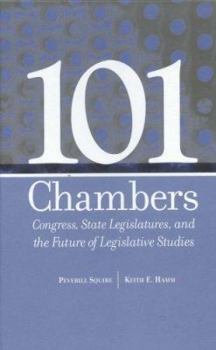101 Chambers: Congress, State Legislatures, & the Future of Legislative Studies
(Part of the Parliaments and Legislatures Series)
Although legislative studies is thriving, it suffers from one glaring weakness: a lack of truly comparative, cross-institutional research. Instead, research focuses overwhelmingly on the U.S. Congress. This unfortunate fixation limits the way scholars approach the testing of many compelling theories of legislative organization and behavior, and it ignores the invaluable research possibilities that comparison with the 99 American state legislative...
Format:Hardcover
Language:English
ISBN:0814209386
ISBN13:9780814209387
Release Date:April 2005
Publisher:Ohio State University Press
Length:224 Pages
Weight:1.20 lbs.
Dimensions:0.8" x 6.3" x 9.2"
Customer Reviews
1 rating
Excellent Comparative Analysis of Legislative Bodies
Published by Thriftbooks.com User , 14 years ago
This book contains excellent academic information on the structure and operations of various legislative bodies. It compares 99 state legislative chambers with the two Congressional chambers. All can trace their origins to colonial assemblies. These chambers have numerous differences, including numbers of members, numbers of residents per district, qualifications to serve, term limits, degrees of professionalism, staffing, pay, rules, organizational structures, etc. Readers learn many useful facts, including as a small sample, some of the following: The U.S. House emerged by using colonial assemblies as models in determining its procedures and structure, including creating committees and establishing leadership positions. The colonial assemblies were all changed by becoming part of a new nation as each state created their own Constitutions which reformed their legislatures. The settlers of 14 Colonial assemblies (East Jersey and West Jersey would later merge into New Jersey) elected colonial assemblies that ranged from initial memberships of 11 in New Hampshire to 42 in Pennsylvania. 12 became bicameral. Pennsylvania started as bicameral in 1682 and become unicameral in 1701. They were established for societal and economic purposes, which colonies having different reasons for creating them. Most states used the British Parliament of the Tudor period as their guidelines in organizing their legislative assemblies. Almost all sought to have legislatures acting separately from the Governor. Most states have Councils that were appointed by and represented the Governor or, in Maryland, the Proprietor. These Councils mostly favored the interests of the King's government. In some states, the Councils and Assemblies initially met together. Eventually, they all met separately. Thus, the authors note that bicameralism was due to political disagreements between the two bodies. These disputes were not class based, they note. The British government turned to bicameralism due to class as the House Lords membership was passed down from father to son. The assemblies gained power during the 18th century. Most assemblies had political power equivalent to that of the Governor by 1763. This allowed the public to openly question the policies of their British government leaders. Colonial representatives were more accessible to their constituents than were members of Parliament. There were 14,367 constituents for every House of Commons member in England compared to 1,200 or fewer constituents for every assembly member in New York, New Jersey, North Carolina, New Hampshire, South Carolina, and Rhode Island. Individuals could petition assemblies. About half of 18th century law passed by assemblies began as petitions. Virginia's House of Burgess met for five days in 1619 compared to an average of 157 days from 1728 to 1749. Most assemblies had standing committees. Pennsylvania and Virginia had subcommittees. Parliament had a tradition of reading





